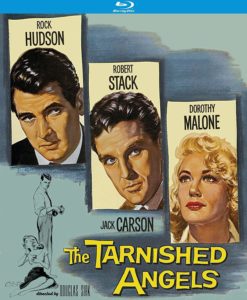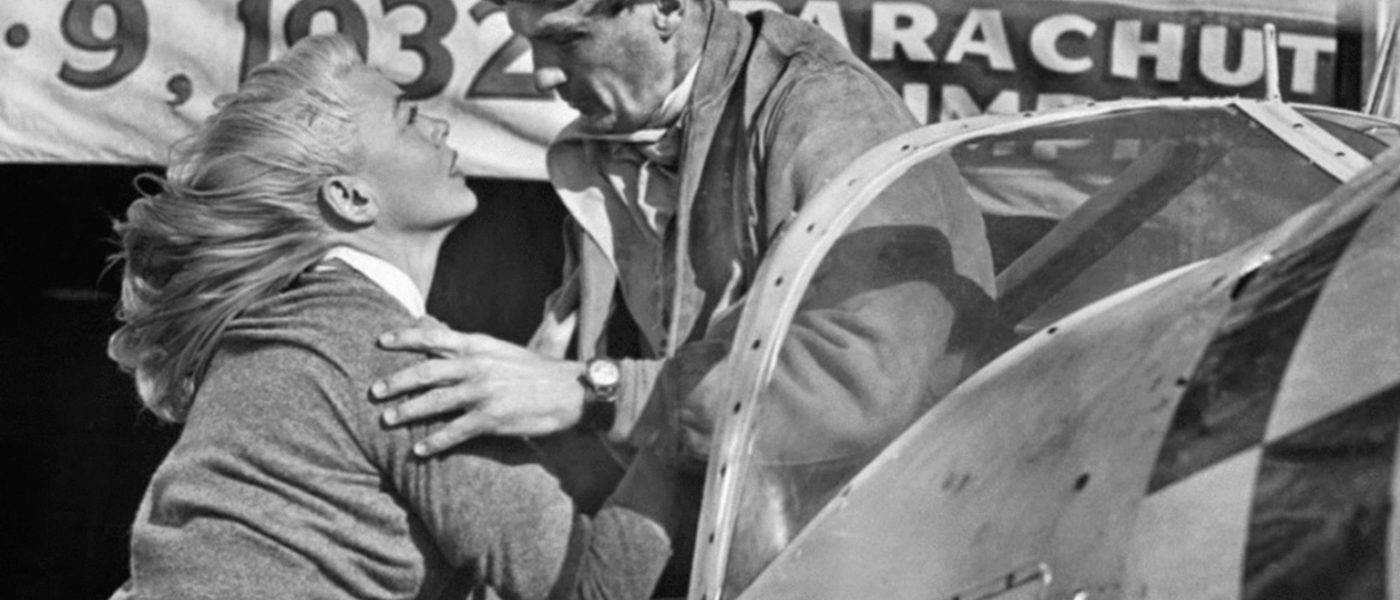Rock Hudson, Robert Stack and Dorothy Malone Soar in Douglas Sirk Barnstorming Melodrama.
DIRECTED BY DOUGLAS SIRK/1957
BLU-RAY STREET DATE: MARCH 26, 2019/KINO LORBER STUDIO CLASSICS

Confidently filmed in black & white, The Tarnished Angels is as lush and full of bravura as its subjects are. The film is a high-flying drama to behold. Directed by Douglas Sirk, one of the greatest and most important filmmakers of the 1950s, what Angels may comparatively lack in the way of bold color (a Sirk-ian trademark, at least in retrospect) it makes up for in terms of its cast. Era superstar Rock Hudson, Robert Stack and Dorothy Malone reunite with the director following their prior recent collaboration, 1956’s Written on the Wind.
Based on the 1935 novel Pylon by William Faulkner, Angels adapts a story so dark and traumatic that even Sirk, at the top of his game in 1950s Hollywood, had to hustle to get the pet project made. Stack plays a down in his luck barnstormer, traveling nomadically from town to town staging life-threatening air shows in order to make ends meet during the Great Depression. Trading desperately on his fading reputation as a flying hero in the Great War, it is clear that Aviation is now his drug of choice, and he’s gone full addict. Malone is his put-upon wife, the daredevil eye-candy of the act. Indeed, all the mechanics and fellow pilots have eyes for her, despite her telegraphed melancholy.

Enter Rock Hudson as an intrepid reporter looking to cover this whole scene. His initial heart-to-heart with Malone is a brilliantly staged as a late-night confessional, each character planted on opposing couches. The two aren’t even positioned to look the other in the eye, and yet the tension that emerges between the two is true and heartfelt. And it’s also stealthily happening right before our eyes. It’s a profoundly baroque realized bit of forbidden connection, chaste and intimate at the same time
Sirk’s realization of all of the film’s airshow daring-do is accomplished if not the prime takeaway from The Tarnished Angels. While much of the actors’ own involvement is clearly forgivable process photography, an early crash scene in which a pilot is thrown from his cockpit directly toward the camera is shockingly visceral. On her excellent and info-packed newly recorded audio commentary track, Film Historian Imogen Sara Smith notes that a life was tragically lost in the making of these sequences. For what it’s worth, the stunning presentation of the film on this disc pays loving remembrance to the fallen individual.

For all of its daytime action and goings-on, there’s an overriding nocturnal glamour about The Tarnished Angels– the kind of glamour that brought with it trouble. Although Smith makes it clear that Sirk and company have smoothed over a great deal of the otherwise un-filmable novel’s darker aspects, she reports that Faulkner himself found it to be his favorite of all the adaptations of his worth. Indeed, The Tarnished Angels, a frequently overlooked entry in the director’s canon,soars with beautiful impressionistic melodrama and satisfyingly emotional pathos.


